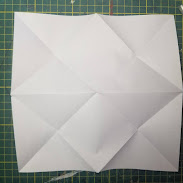As this project is physically going to be made, I have to take into account numerous factors in terms of the creation of the piece being malleability, flexibility, thickness, opacity, manipulations, cost of resources, knowledge gain, and most importantly, the overall time period this will take into account for. But anyway I'll talk about that later in this post, here is the research done on the articles and some thoughts on them.
Haari & Deepti
'Haari & Deepti' aka Deepti Nair and Harikrishnan Panicker are an artistic couple duo whos pieces utilize the "shadow box", a box or frame of sorts containing layers of cut-paper silhouettes which then form a narrative when light is cast through their display. Their pieces are often framed by some sort of scenery providing dark shadows to contrast to the centre cavities of dialogue of the pieces.
What makes their pieces most visually hypnotizing is their usage of light when displaying the narratives. Furthermore, every paper layer is hand-cut! When not using dramatic lights, the pieces contrast become significantly lower and lose their effect, however, with the light, the couple stated that...
"What amazes us about the paper cut light boxes is the dichotomy of the piece in its lit and unlit state, the contrast is so stark that it has this mystical effect on the viewers."

'

Personally, this one intrigues me the most as the narrative aspect is super interesting to play with. Also, I personally love the dramatic nature their pieces poses in general as they have high contrast almost like a baroque piece but uses caricature nature and basically defined 'white and black' panels which further become more dramatic with the lighting and depth placement.
Hoang Tien Quyet
Hoang Tien Quyet is a Vietnamese-based artist that utilizes the technique of wet-folding origami, this allows him to manipulate the folding technique of origami more fluidly than normal techniques providing a malleable substance without tearing the material. His process can be simplified to dampening paper to manipulate its surface/flexibility.
Like Hoang Tien Quyet, I also played around with origami as a child so seeing this technique was interesting as its kind of almost like paper-mache in a sense, wet pieces of paper to form a shape of an object and such.
Previous Ideas that influence present decisions and thoughts...
To better learn stuff I usually do some sort of application of knowledge learnt or concerns and concepts that come to mind.
Below is an idea that I always come back to that I never truly fully do as there is a bunch of risks with it. Mainly being perspective and positioning. It is basically almost like a paper flipbook but instead, it's a still standing sculpture with numerous panes that have some sort of opacity and imagery or cuts within them to create an image all together when placed in their cylindrical positioning. Yeah, a lot.
I did some math above to figure out the "seen" portion of each pane if looking directly at it but really forgot one big thing is that perspective kind of slants everything to their perspective points. Whether or not that would be bad is something I still think about, maybe that when cut into the panes that the imagery also slants and fixes everything? Trial and error I guess. *and even then this was with plexiglass in mind and not paper.
Summary: thinking of the panes as 2-dimensional objects are fine in theory and digitally however their thickness can vary in reality. Really being thin 3 dimensional rectangles
*side-side thought: the strength of paper in terms of tension & overall keeping form of shape
(analogy steel beam is strong but when elongated it faces stress from its own weight)
translation into paper...
Now let's talk about origami and how its effects also are being thrown into my mind...
One thing during Hoang Tien Quyet's article was that they used water to manipulate the malleability of the paper. First off origami paper is usually a thickness less than cardstock but thicker than printer paper. Another thing to take into account is the texture of paper after water interacts with its surface, some crazy wrinkles depending on the amount of water and paper material. As my patience varies to extremely patient and can wait for months to pure anger, I thought of a different method I remember seeing when I had a phase of origami, using air to bend and overall place the origami into a box formation. (though probably a difficult through the process to think of as taking into account again tension and basically the overall structure of what is keeping form and expanding from air psi.)

Again, sorry for the long post.
Seeya
 '
'

















Comments
Post a Comment